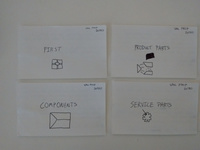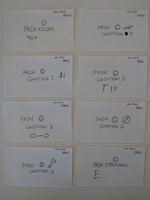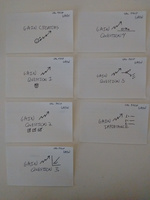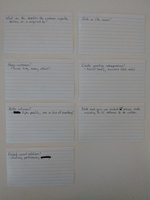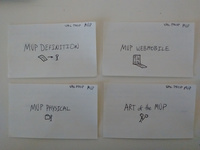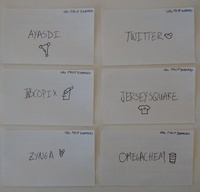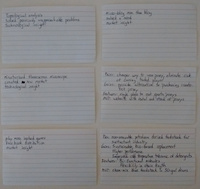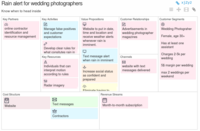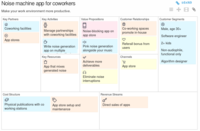Fourth Stage: Value Propositions
Research of known effective materials:
Udacity course: How to Build a Startup, Lesson 5: Value Propositions
All sections 1 - 27
Strategyzer: 10 Characteristics of a great Value Proposition checklist
Strategyzer: Sell Your Colleagues on Value Proposition Design
Strategyzer: Value Proposition Design book Preview
Incorporation:
Card deck 1 of 6 INTRO
Chapter 1. Value Proposition What product or service are you building, for who, and what does it solve for those people? It's about satisfying a customer need, not just you thinking: "What a great idea". Chapter 4. COMPONENTS 1. The features of your products and services. 2. What gain are you creating for customers? 3. What pain are you solving for them? The goal is the smallest possible feature set that solves these pains and creates these gains for the customer. That is the Minimally Viable Product. Chapter 9. PRODUCT Which are part of your value proposition? -manufactured goods, commodity product... Which intangible products are part? -copyrights, licenses... Which financial products? -financial guarantees, insurance policies... Which digital products? -mp3 files, ebooks.... The product is the whole package of all the above Chapter 10. SERVICES Which core services are part of the value proposition? -Consulting, a haircut, investment advice... Which pre-sales or sales services? -help finding right solution, financing, free-delivery Which after-sales services? -free maintenance, disposal... What is it that your product features do?
Card deck 2 of 6 PAIN
PAIN KILLERS
What are you going to reduce or eliminate for the customer?
Chapter 12. PAIN Questions:
Produce savings? Time, money, effort
Feel better? Frustration, annoyance, headaches
Fix solutions? New features, better, faster
End challenges? Easier, eliminate resistance?
Impact social consequences? wipe out negative social
consequences or add to social status?
Eliminate risk? Financial, social or technical risk
Chapter 14. PAIN Importance
Rank each pain according to its intensity and frequency
Card deck 3 of 6 GAIN
GAIN CREATORS What are the benefits the customer expects, desires or is surprised by? Chapter 15. GAIN Questions Happy customers? Save time, save money, save effort Better outcomes? Higher quality, more or less of something Exceed current solutions? Features, performance, quality Job or life easier? Create positive consequences? Social (need), business (more sales) Chapter 16. GAIN Importance Rank each gain your product and services create according to its relevance to the customer.
Card deck 4 of 6 MVP
Chapter 19. MVP Definition The first instance of your product or service that is delivered to customers. What is it that customers tell us that they will pay for or use right now. It is not a beta, tell customers it is the MVP. Chapter 17. MVP Physical Always invest a day or two building a physical product mockup. Something that customers can see and touch. Chapter 18. MVP Webmobile Build a "low fidelity" app or website to test the problem. This helps you avoid building products no one wants. Chapter 21. The art of the MVP It's based on interaction and iteration and understanding customers jobs, pains and gains. For new markets, don't ask about features, ask "How do they spend their time?"
Card deck 5 of 6 META-Value Prop
Chapter 22. COMMON MISTAKES
It's just a feature of someones else's product
"It's nice to have" instead of "got to have"
Not enough customers care
Chapter 23. QUESTIONS:
Competition:
What do customers do today? Make BMC's for the competition.
Technology / Market Insight:
Why is the problem so hard to solve?
Why is the service not being done by other people?
Market size:
How big is this problem?
Product:
How do you make it once you understand the customer needs?
Chapter 24: TWO FORMS:
Technology insight:
Typically applies to hardware, clean tech and biotech.
Market insight:
Changes in how people work, live, interact and what they expect.
Both forms need to solve pains and create gains for the customer.
Chapter 25: TYPES
Technology Market
More efficient lower cost better distribution
smaller simpler better bundling
faster better branding
combine technology and market insights for the sweet spot of value
propositions.
Card deck 6 of 6 Examples
Technology Insights Ayasdi - topological analysis, solved previously unapproachable problems Inscopix - smaller fluorescence microscope - created new market Market insights Zynga - play more involved games - facebook distribution Twitter - micro-blog more than blog - solved a need JERSEYSQUARE Pains: cheaper way to wear jersey, eliminate risk of owning traded player Gain: provide alternative to purchasing counterfeit jersey Features: single place to rent sports jerseys MVP: website with rental and stock of jerseys OmegaChem Pain: non-renewable petroleum derived feedstock for surfactant industry Gains: Sustainable, bio-based replacement. Higher performance Improved cold temperature tolerance of detergents Features: Bi-functional molecules Flexibility in chain length MVP: chem-mix blue feedstock in 50-gal drums
Execution:
Lessons learned:
36 cards with about double the total content of any previous learning stage. Still took linear amounts of time to memorize when grouped into individual card decks. Re-merged with randomization for surprisingly no impact to time required for memorization and incorporation.
Now making a new set of business model canvases for various problems I'm working on with these better value proposition ideas.
The creation of these bmfiddles is showing many new frustrations and lack of clarity. Especially around the value propositions and customer segments - looking at others briefly from the udacity materials, then will recreate full BMC's for practice. Excellent - that instantly shows you were confused about what goes in the customer segment box. It's the persona, not the matching pains and gains. So execute a series of bmfiddles based on teh various ideas you are working on that include:
- A pain solved for customer
- A gain created for customer
- Features for pain solved and/or gain created
- mvp
